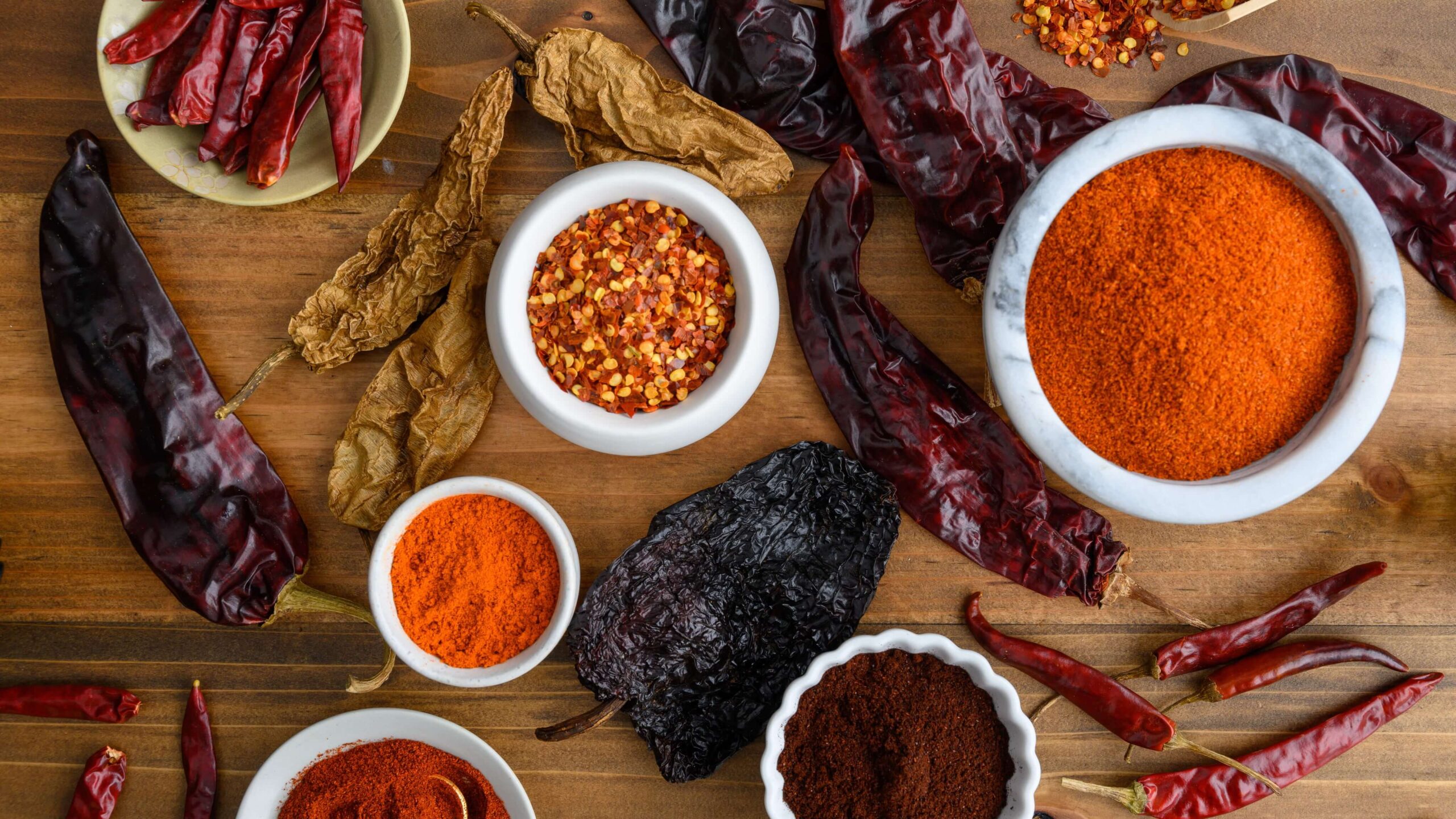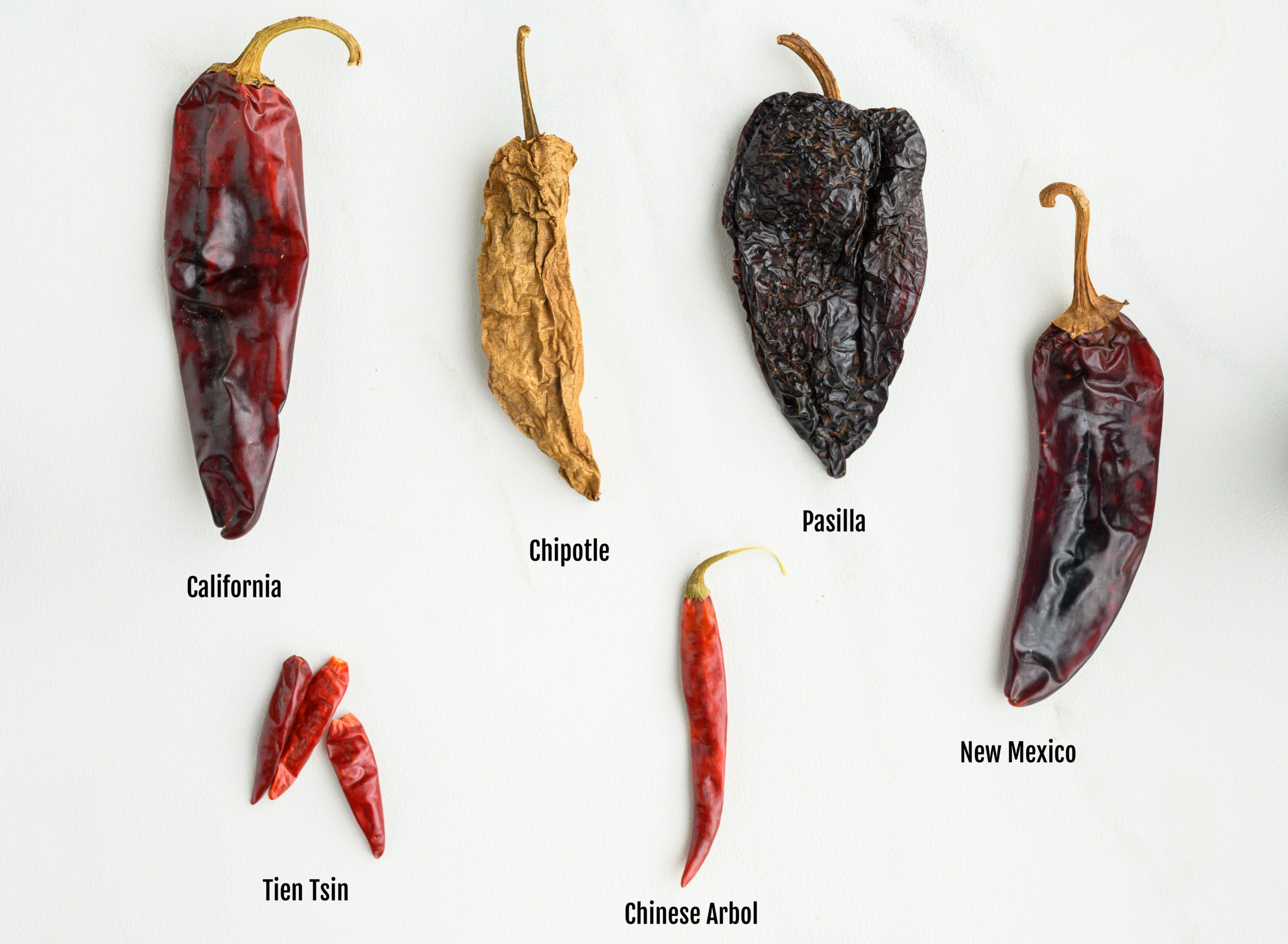The spicy food trend is about more than appealing to personal taste; it’s about offering a bold option for your most fearless consumers. As spicy foods in the U.S. are becoming progressively more popular, those who can ‘handle the heat’ wear their tolerance like a badge of honor. With several hot sauce brands attaining ‘cult status’ and hot sauce options becoming commonplace in restaurants across the country, it’s clear that spicy food is here to stay. And what’s at the center of the spicy food trend? The ever-versatile chili pepper.
In this blog, we’ll showcase the flavor, history, and common uses of chili peppers, and discuss the many ways they’re used today.
Flavor + Heat

Describing the flavor of a chili pepper is challenging because there are over 200 varieties of chili peppers and each variety has its own unique flavor (ranging from sweet to smokey).
Sweet – Typically the larger chili pepper varieties. These tend to be the most mild.
Smokey – Typically the smaller chili pepper varieties. These tend to be the hottest.
Why Do People Like Heat?
Chili peppers contain a compound called capsaicin and this compound is what causes your mouth to burn when you eat one. When you ingest capsaicin, the pain receptors in your brain are triggered to signal danger and endorphins are released (these are your ‘happy hormones’). Some theorize that people who like spicy food become ‘hooked’ on it because of this hormonal rush. Evidence also suggests that people may like spicy food because they’re attracted to the thrill that comes from feeling like they’re in danger when they know that they’re not actually in any danger at all (like the feeling you get when you ride a roller coaster or watch a scary movie).
How is Heat Measured?
The most common unit of measurement for heat in chilis and peppers is Scoville Heat Units (SHU). With peppers ranging from 0 -2,000,000 SHUs, this scale is exact and great for food production and testing, albeit a bit complicated.
The Appeal of Complex Heat
As spicy foods increase in popularity, so do specific flavors. Consumers are not just selecting products based on heat level; now, they prefer specific flavors such as serrano, jalapeno, and habanero. Industry trends suggest that heat will become less of a focus for brands; products with complex chili pepper flavors will take center stage to appeal to a larger demographic.
Chili Pepper Challenges
In the foodservice industry, the biggest challenge that arises when handling chili peppers is consistency.
When they’re used in cooking, the perceived heat of a chili pepper can intensify depending on a number of factors such as the pH level of the food, processing methods, and whether or not the dish is gum/starch-based or oil/water-based. In fact, a dish may taste up to 40% hotter because of these other factors alone.
A chili pepper can taste very different depending on the meal that it compliments.
If you add chili peppers to an oil-based recipe, the oil interacts with the heat of the chili peppers and acts as a catalyst, making the taste hotter after a few days than it does on the first day. Conversely, if you add chili peppers to a dish that is gum or starch based, the heat and flavor may be muted.
For food manufacturers, the biggest challenge lies in creating products that have stability and consistency. Labeling food as either mild, medium, or hot is only possible if the manufacturer understands the chemistry of the dish and how the chili pepper interacts with the other ingredients. For this reason, foods containing chili peppers must undergo extensive testing to ensure that the heat and taste of the dish maintain stable over time. Finding a perfect balance of heat and flavor is a tedious process that often requires experimentation.
Appearance

Chili peppers come from the Capsicum Annuum or Capsicum Chinense plants which varies in appearance. Typically, the plants are shrubby and range from 1-4 feet, depending on the variety. These plants flower and their blooms yield chili peppers.
This is what some of the most popular varieties of chili peppers look like:
Habanero – These peppers start off green, then ripen to either yellow, red, orange, or white. They measure from 1-2.5 inches long and are nearly just as wide.
Cayenne – These peppers are very bright red, thin, and pointed. They are typically 3-5 inches long and are commonly dried.
Jalapeno – These peppers start off as bright green, and darken as they ripen. Jalapenos have an almost waxy skin and typically grow to be 4-6 inches long.
Poblano – These peppers start off dark green and ripen to a brown or red color. Poblanos can grow to be as large as a bell pepper, but are thinner and more pointy.
Bell Pepper – Bell peppers can be a variety of bold colors: Red, yellow, orange, green, and even purple. They are large and blocky, ranging from 2-5 inches in diameter and 2-6 inches in length. While related scientifically to other chili peppers, they are often considered a separate category since they have no heat.
History + Origins
For a long time, chili peppers were believed to be native to India. Today, research shows that they originated in French Guiana. While some accounts debate the details, it’s generally accepted that chili peppers were discovered in the New World by Christopher Columbus who found them on his quest to find black peppercorns (which were very valuable at the time). He brought chili peppers with him to Spain. From there, chili peppers were introduced into the vast Portuguese trade routes, then dispersed into Europe, India, and most of the world.
Although they’ve only been known worldwide for a relatively short amount of time, chili peppers are an ancient crop that date back thousands of years. In ancient times, chili peppers were commonly used by the Mayans, Aztecs, and Incas. Chili peppers were not only used to spice and flavor food, they were also used in various rituals. The Mayan and Aztec people believed that their pungency could cleanse and protect homes and that their heat could cure illness.
Quality, Sourcing & Safety
It is imperative to have a reliable supplier for chili peppers and chili pepper products to ensure product consistency in heat and flavor. Sourcing from different suppliers or from unreliable suppliers may result in the product being unpredictable. Weather variables, sourcing, processing techniques, and storage conditions all affect the heat and flavor of chili peppers, so do your research before choosing a supplier.
Pacific Spice is dedicated to producing the highest quality spices. To do that, we source, process, and clean locally. Under our full control, we can ensure that our strict manufacturing methods far exceed the quality standards of U.S. food manufacturers. This results in products that are pure, free of contaminants and adulterants, and a flavorful addition to your favorite dishes.
Uses
When the chili peppers are fresh, they’re used as a vegetable. When they’re dried, they’re used as a spice.
Chili peppers are a favorite around the world and are featured in a number of world cuisines. To name a few…
Mexico: Chili peppers are a key ingredient in salsa, mole, and chorizo.
Italy: Puttanesca, the famous red sauce from Italy, contains chili peppers.
Louisiana: Red pepper and cayenne pepper are used to flavor gumbo and cajun shrimp.
Because of the vast variability of flavors and heat, chili peppers can complement almost any dish. For smokiness, add chipotles. For heat, add jalapenos or habaneros; for a sweeter taste, add bell peppers.
Get creative! And find the chili peppers that match your taste (and tolerance!).
Health Benefits
For countless years, chili peppers have been hailed for their warming, therapeutic benefits. Recent research even suggests that chili peppers can greatly reduce the risk of death from stroke or heart attack.
Storing
When storing chili pepper spices, it’s important to keep them in an airtight container in a cool, dark, dry area. Store them above the ground and away from the wall to ensure that they stay dry. Properly stored spices should maintain flavor and quality for up to one year
PSC Chili Peppers
At Pacific Spice, we have a variety of seasonings and spices that star chili peppers. Our collection has something for everyone, especially if you’re not afraid of a little heat.
Here’s a list of our chili pepper spices:
- Chili Pepper California Ground
- Chili Pepper Chipotle Ground
- Chili Pepper Guajillo Ground
- Chili Pepper Habanero Ground
- Chili Pepper New Mexico Ground
- Chili Pepper Pasilla Ground
- Chili Pods California
- Chili Pods Chinese Arbol Whole
- Chili Pods Chipotle
- Chili Pods New Mexico
- Chili Pods Pasilla
- Chili Tien Tsin Whole
- Chili Flakes
- Cayenne Pepper X-Hot
- Cayenne Pepper Hot
- Cayenne Pepper Mild
How do you like to incorporate the crave-able fire of chili peppers into your daily life?
Sign up for our newsletter and ask for a sample!

